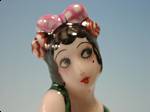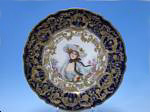
|
■ Introduction It is not unusual for a work of art (paintings) or antique to become extraordinarily valuable in a future age. The impressionist masterpieces and porcelains of the Lee dynasty are a readily observable example of this phenomenon.  Old Noritake is another such example. Art critic Mr. Unno beautifully describes the sudden 're-emergence' of Old Noritake Art Deco as a 'rediscovery'. It is just a matter of time before we see Old Noritake Art Deco take on a higher profile and increased recognition in Japanese and American art and design. Recently, art museums that collect porcelains have re-oriented their focus toward modern Japanese pottery. They have begun collecting this fine porcelain ware, despite their financial hardships. We think the increased value of wares from a previous age, coupled with the new directions that are now being emphasized in art museums are the reasons behind the rapid increase in the demand for Old Noritake, while many other areas are in depression. This renewed interest in Noritake explains the numerous exhibitions that are being held in department stores etc. throughout Japan. However, many of these exhibitions focus on marketing, and we rarely see exhibitions that present the true charm of the authentic Old Noritake genre. On this Internet site, we aim to present the entire picture of Old Noritake so that more people can appreciate and deepen their knowledge of this enchanting style. This has not been achieved in exhibitions or on other Internet sites. ■ About this Site One of the aims of this site is to present Old Noritake by allowing a number of general collectors to exhibit their own items. Such a collection is unprecedented. We hope many collectors support this idea and contribute to this gallery in order to make it attractive and global.  This site divides Old Noritake into two categories: Art Deco and Art Nouveau(Nippon). In addition to these categories, we have established an independent section for Cup and Saucer, which is the best-known form of Old Noritake. We have also presented other porcelains such as Coralene, Hyochien and Harumitsu under the heading of 'Old Noritake and Others'. In Collector's Plaza, we have set up a 'communication' for collectors to exchange information. The Plaza also provides information on books. We would like to continuously present new arrivals. Your participation will be highly appreciated. We hope that you are as excited about our new site as we are. ■ Collection Collecting is a very common hobby, and people's sense of values is very diverse. These days, a seemingly limitless variety of items are considered collectable. Any collectable may be highly valued if it is widely appreciated. Nonetheless, there are criteria for collectables to gain mainstream acceptance. For example, there must be a wide variety of different types of items within the field. If you are collecting a popular type of item, you can always find something new, even though you may already have an extensive collection. Other criteria include: (1) Items must be able to be exhibited and readily observable. (2) Items must be able to be bought and sold, and domestic and/or international markets must exist for those items. (3) A limited quantity of items must have been produced within a limited period. If the items meet the above criteria, they will be appropriate for collecting. Old Noritake satisfies these criteria well. However, they do have one disadvantage; they can be broken. The current trend in the world today is toward digitalization. Handmade products provide an antidote to digitalization and it is therefore quite understandable that the value of handmade products is increasing. ■ Classification It is not easy to categorize Old Noritake because it is so diverse. Furthermore, the Old Noritake genre encompasses a wide variety of production techniques; thus making classification quite difficult. On this web site, we have classified the Art Deco pieces primarily in terms of their use and form (see the chapter on Art Deco). We have classified the Art Nouveau pieces in terms of their production technique, as well as their use and form (see the chapter on Art Nouveau). Old Noritake is usually divided into two styles: Art Deco and Art Nouveau, which was produced during the 1920s and 1930s. However, it is also possible to categorize Old Noritake in terms of type (dinnerware or fancyware) or market (marketed domestically or exported). In reality, however, the subjects are fancyware in many cases, and fancyware was exported. The fancyware that is currently in Japan has been brought back from foreign countries. The domestic-use products are generally inferior to the exported products in terms of production techniques, decoration and color - the exception being some pieces produced specifically for exhibition. This situation is quite understandable. The superior quality ware was exported in order to bring in foreign currency. Domestic-use products have therefore been excluded from this homepage, except for some of the finer quality products. Please have a look at the plate on the right.  This plate can be classified as a 'portrait' that uses the transfer technique, and further classified as 'gold impaste' or 'cobalt'. Of course, it could be classified as 'plate' in accordance with its use and form. (It could also be classified in terms of the name of the subject, such as Queen Louise or Madame Recamier.) On this web site, this plate appears in three sections: 'portrait', 'cobalt' and 'plate'. This is an example of an item that is listed in multiple sections. |
